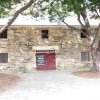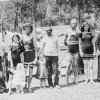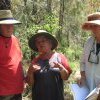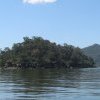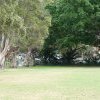1880s
A well known Koori man, Tarpot lives in a cave at Mosman Bay above the ‘Barn’, the Scout Hall at Mosman Bay. He survives by catching fish and doing odd jobs for local people. He usually dresses in cast off naval uniforms and is still alive in 1888. He is at one time caretaker of the Milson family slaughterhouse at foot of Willoughby St in Slaughterhouse Bay (now Careening Cove). However, Mann describes him as a Maori, and may have been one of the boys brought by Samuel Marsden from New Zealand. (Mann 1932, p.196)
Photo taken by Harry Wolstenholme of Aboriginal group of women, probably near Wiseman’s Ferry on the Hawkesbury River. (Jacobs 2000)
Mrs Benns (and husband Joseph Benns) are still living on Pittwater. She acts as midwife to all the families along the Hawkesbury River.
Marriage of Hannah Matilda Ashby to Henry Stanford Boyd. These descendants of Bungaree have many children including Jean Boyd and Matilda Ellen Boyd.
1880
Turo Downs Aboriginal man comes from Queensland to live in Brisbane Waters at Hardy’s Bay. Turo became an employee of Captain Anderson. A great swimmer and runner, he impresses those who see him when he dives from the rocks at Kilcare Beach to emerge with a lobster. He is remembered as a gentleman, astute, polite, and with good English. He is buried at Kincumber Churchyard where a stone bears tribute “respected by all”. He dies in 1942 aged 86.
1881
Church missionary Daniel Matthews visits Aboriginal camps along the Harbour to offer supplies and care, (and to entice people to his mission station at Maloga). On 25th July he writes,
“went to North Shore – gave rations for children – meat, flour, tea and sugar. In evening called at black’s camp – glad to see me, conducted by ’fire sticks‘ [led by Koori guides] blacks drunk – back to Sydney in ferry – saw Jane half caste street walking at night”.
Matthews continues,
“Aug 2nd Went by steamer to Manly, broke up camp, brought Harry, Eliza, Harriet and 5 children to Mr Hills. All readily consented to come. Trip in steamer lovely view – great crowd of blacks in Mr Hill’s yard – fire, plenty of food and blankets … alright except Mrs Beckett and Charley Abbot’s wife … I went to railway station about passes. Mr Gribble (Head of another mission station, Warangesda) to Botany Bay for Ellen and boys. ... Met Sir H Parkes... [the Premier, who] consented to blacks getting the same rations at Maloga [a mission station in Victoria run by Matthews] as in Sydney”. (Daniel Matthews 1881, Extracts from Diary, AIATSIS MF)
Some individual missionaries such as William Ridley continued to press the government for action to help Aboriginal people in Sydney.
Death recorded of Aboriginal child: Kitty 14 years old at Milsons Point.
1883
Aboriginal Protection Board established by New South Wales Government (later to become known as the Aborigines Welfare Board). The Board begins to remove Aboriginal children from families, previously done only by missionaries. The Board’s powers are legislated through an Act of Parliament in 1909. The Board’s policy is that all Aboriginal people should live on reserves. In 1883 there are 25 Aboriginal reserves in NSW totaling 1,414 hectares. By 1900 there are 133 reserves. Aboriginal people are encouraged to farm these reserves and farm equipment is supplied. Most of these reserves had insufficient food but the Aboriginal people are expected to be self sufficient. Supplies of rations were only given to the aged, sick and children.












